Evolution of the VIRTUAL REALITY and CYBERTHERAPY
This is the english translation from italian of my post Evoluzione della VIRTUAL REALITY e CYBERTHERAPY - written and translated by @girolamomarotta
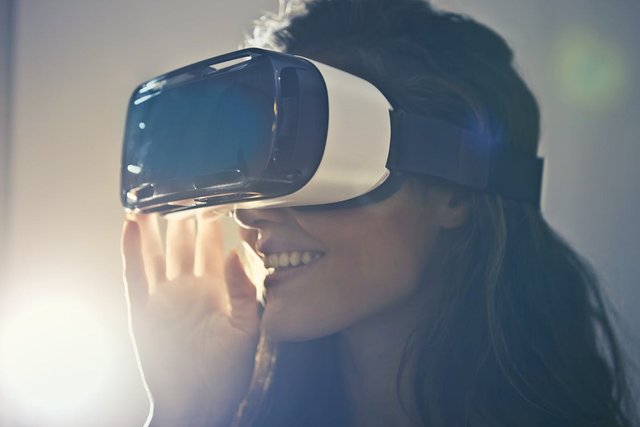
Image CC0 creative commons
On Saturday 26 May 2018, at the Campus - iOS Developer Academy of Federico II University in Naples, Italy, was held the conference "Technologies for learning and communication in autism", organized by the Federico II University of Naples and Irfid (Institute of Research, Training and Information on Disability).
As part of the meeting, augmentative and alternative communication systems were presented, tools able to ensure an improvement in communication, transforming into words all that is expressed with limitation to non-verbal forms of interaction.
Among these, they talked about some Virtual Reality systems used in the treatment of disorders, addictions, traumas and neuro-degenerative diseases.
VIRTUAL REALITY
Virtual reality (or VR) is a technology that offers the possibility of interacting with a reconstructed environment to be as similar as possible to the real one. Its application is supported by the use of tools such as helmets or virtual reality headsets , headphones, gloves and suits equipped with motion sensors.
Over time, the technology behind VR has evolved, have been made discoveries and improvements.
Let's go to see the most important steps of the system development.
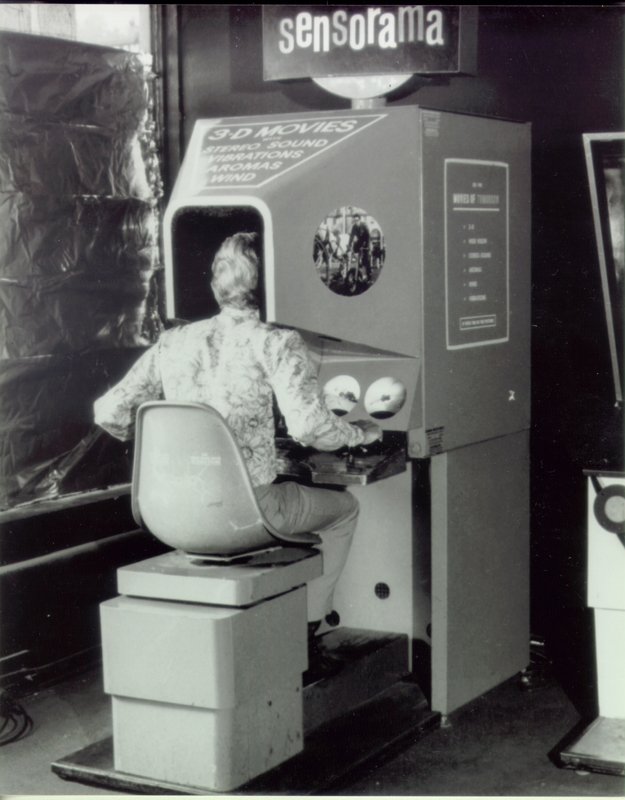
Image CC BY-SA 4.0 Source
1962
The American director Morton Heilig presented a system called Sensorama, with the intent of involving all the senses of the spectator in the vision of the film.
The machine consisted of a cabin with a 3D vision, obtained thanks to an input cone that ensured both a frontal and peripheral view, in a stereoscopic screen.
It was also equipped with instruments able to transmitting vibrations, generating olfactory and tactile stimuli, including a real wind tunnel.
Heilig's experiment was not particularly successful because of its difficult adaptability to the cinema of the time and, above all because of the high cost. So, it remained an idea without any investor interested in developing it.
Heilig also designed a first headset prototype, a system called HMD (Head Mounted Display), with stereo headphones and lenses with 140-degree viewing angles.
But he was never able to build one.
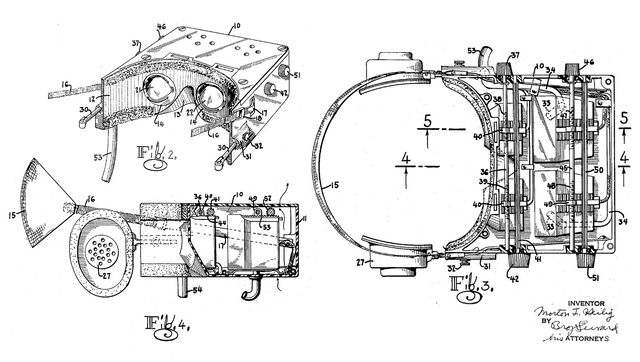
Image CC0 creative commons
1965 - 1968
The first wearable device was developed and built by the scientist Ivan Sutherland, always in the United States, at the University of Utah.
It was composed of two cathode ray tubes, through which it was possible to see geometric figures in wireframe overlapping the reality. It was the first applied concept of augmented reality.
But the system was still difficult to use, because it was really very heavy. In fact, it was necessary to fix the support arm to a cross-shaped structure mounted under the ceiling. This characteristic inspired its name, "The Sword Of Damocles".
1977 - 1999
In 1977, MIT (Massachusetts Institute of Technology) created the Aspen Movie Map, a software that reproduced an interactive map of the city of Colorado and allowed the user to make a virtual journey with different options, such as climate or historical era.
This innovation is considered as the first development of the technology behind Google Street View, born about 30 years later.
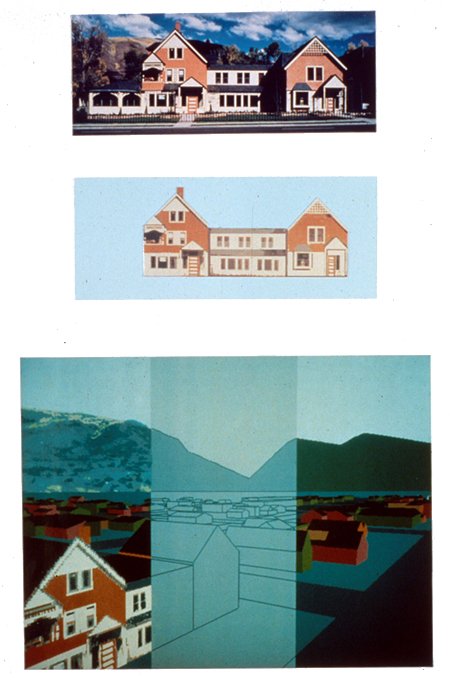
Image CC BY-SA 3.0 Source
A few years later, in 1982, VR technology started to be applied to the market sector in which it would later be used and developed: the gaming.
The first company to invest on research and development of the technology was ATARI, which created a dedicated laboratory, the Atari Research LAB.
Also in this case, the experiment was a failure, because a period of crisis occurred in the world of video games and the company had to close it.
Some of the men involved in the project were Jaron Lanier and Thomas Zimmerman, who continued their research, founding a new company, the VPL Research, with the purpose of making the virtual reality reproduction systems within reach of a mass audience. So they launched two devices, the DataGlove and the EyePhone.
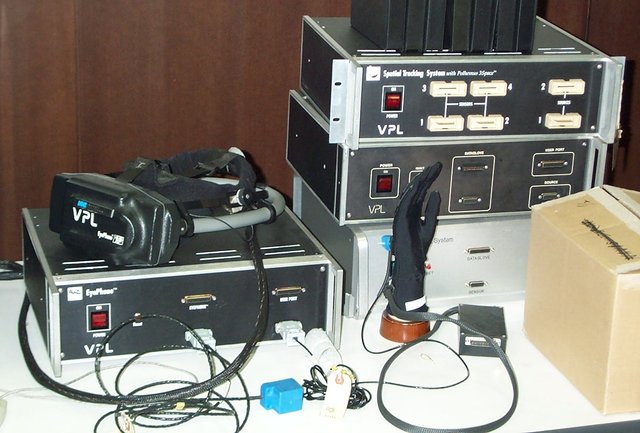
DataGlove and EyePhone
Image CC0 creative commons
The first was a glove equipped with 6502 microsensors, connected to a computer that duplicated the data received and reproduced movements and gestures.
The second was an HMD system capable of projecting simulated images and detecting head movements.
Since that time, all the major gaming companies started working on VR devices and interfaces, first of all Nintendo, with its PowerGlove. Produced by Mattel for Nintendo, it immediately presented imperfections from the point of view of gameplay precision and was soon shelved.
Then was launched Virtuality 1000CS, a device created by the Virtuality group, based on an AMIGA 3000 system, consisting of an audio/video headset, a joystick for interacting with virtual reality and a circular box for the body movements . It was, once again, a failure, especially commercial, because the amount required to purchase it was $ 60,000.
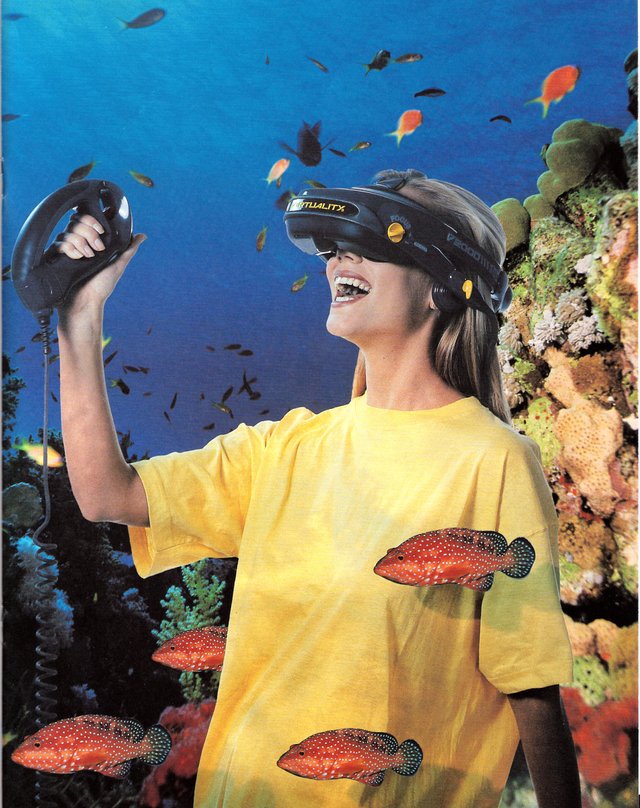
Image CC BY-SA 4.0
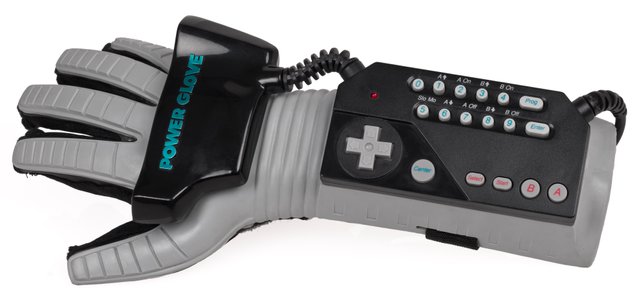
Image CC0 creative commons
Afterwards, in 1993, SEGA also developed its headset, the SEGA VR, a product with a modern and captivating design that was the evolution of a prototype already present in the arcade game rooms.
Designed to be used on its consoles, mainly on Saturn, it would have been launched at the price of $ 200, but in the testing phase the project was shelved, both for development problems and because of the frequent headaches accused by those who tried it.
The same end did the Virtual Boy, still a Nintendo device. In this case, the product was launched as a portable console and with VR technology, but presented many problems of low resolution and graphics (the image appeared in red and black) furthermore it was considered too heavy to be really definable as a portable device.
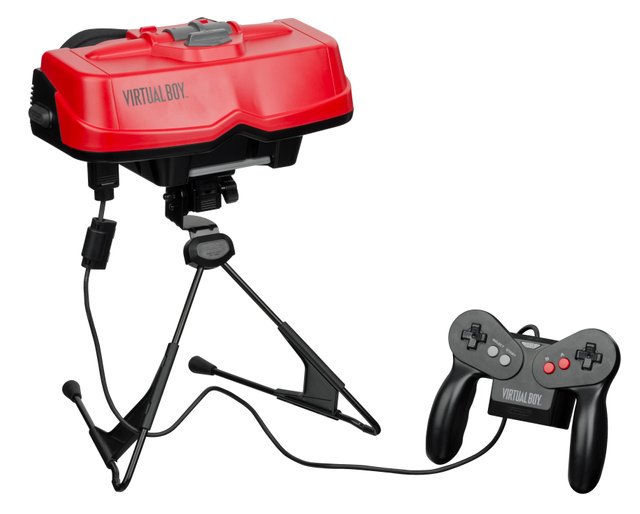
Nintendo Virtual Boy, 1995.
Image CC0 creative commons
2010
For a whole decade, after the numerous failures, the research on VR technology stopped and the interest around this type of innovation definitively disappeared.
In 2010, Facebook decided to dedicate a team belonging to the multi-disciplinary Facebook IQ research group, to the study of a tool that could bring advertising from television to the web and, in particular, to their social network.
So, two years later, they noticed the work of Palmer Luckey, a Californian student founder of Oculus VR, a company that had just received a loan of 2.4 million dollars thanks to a crowdfunding campaign on Kickstarter .
Luckey had created Oculus Rift a prototype of a VR headset with clearly defined characteristics:
- High resolution (2160x1200)
- Lightness (weight 470 grams)
- Possibility to be used for a long time without stressing the eyes
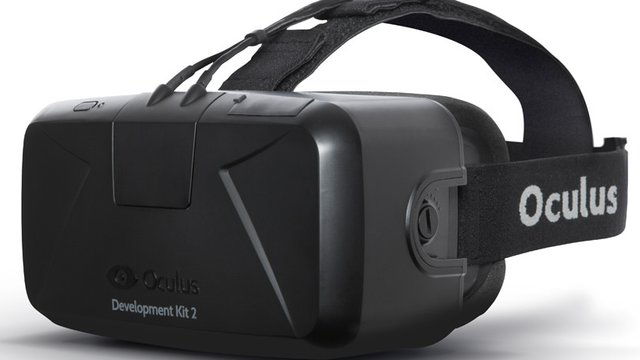
Oculus Rift DK2
Image CC BY-SA 2.0 Source
The Facebook team, after some tests, was positively impressed by the qualities of the product and in March 25, 2014, Zuckerberg bought the Oculus VR, paying 2 billion dollars for the acquisition.
Here's how Mark Zuckerberg commented:
“This is just the start, after games, we're going to make Oculus a platform for many other experiences. Imagine enjoying a court side seat at a game, studying in a classroom of students and teachers all over the world or consulting with a doctor face-to-face - just by putting on goggles in your home.
This is really a new communication platform. By feeling truly present, you can share unbounded spaces and experiences with the people in your life. Imagine sharing not just moments with your friends online, but entire experiences and adventures."
GIUSEPPE RIVA: CYBERTHERAPY AND CYBERPSYCHOLOGY
Returning to our conference, among the various guests who took part, Giuseppe Riva Ph.D. presented some of his studies concerning the application of virtual reality in the treatment of behavioral disorders and development of the nervous system disorders.
Giuseppe Riva Ph.D. at the University Cattolica del Sacro Cuore, President of the International Association of CyberPsychology, Training, and Rehabilitation and Head Researcher of the the Applied Technology for Neuro-Psychology Laboratory - ATN-P Lab of the Italian Auxologic Institute. He is also the Italian scientist with the most number of peer-reviewed publications in the field of virtual reality applied to health treatments.
He was the first to introduce these technologies in the field of psychology and rehabilitation, thanks to the work done at the ATN-P Lab.
Active since 1994, this structure is one of the most technologically advanced in the world and the only one in Italy to be equipped with CAVE (Cave Automatic Virtual Environment), a room with a simulated 3D environment, in which is practiced an immersive virtual reality experience, thanks to output devices such as helmets, headsets or goggles, and input devices such as gloves and joypads.
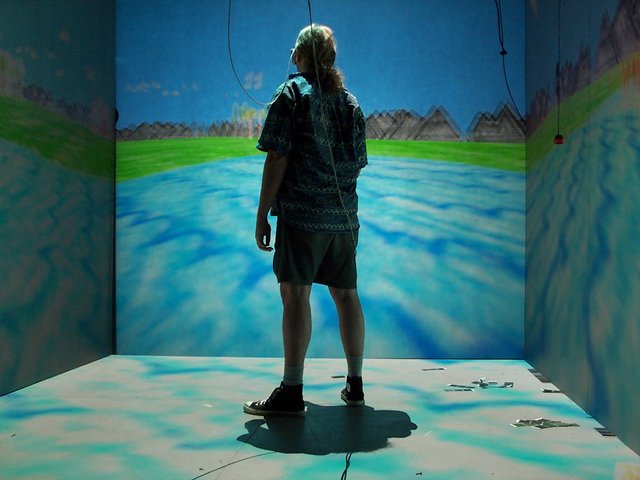
CAVE Electronic Visualization Laboratory, Illinois University, Chicago. 2001
Image CC0 creative commons
The result is very effective, as the motion capture system is able to detect in real time, position and movements of the head and hands. Immersiveness is such as to bring the patient to integrate with the virtual environment until he can no longer distinguish it from the real one.
Thanks to this feature, the system can be used to simulate a specific environment, perhaps familiar, and to moderate physical and psychological disperceptions, or to generate a specific type of sensation.
Riva's studies have concerned and involved different areas, thanks to the multi-sectorial nature and to the great versatility of the developed techniques.
The basic concept is applicable in fact to different therapeutic areas:
- Burns treatment
- Control of stress situations
- Treatment of eating behavior disorders
- Treatment of learning development disorders
- Treatment of neuro-degenerative diseases
A beautiful experiment that makes understanding the validity of cybertherapy, can be found on YouTube, in a video that I will report in the sources, entitled Conversations between self and self as Freud, extrapolated from a study conducted by the team of University of Barcelona, Sofia Adelaide Osimo, Rodrigo Pizarro, Bernhard Spanlang and Mel Slater, published on Scientific Reports on 10 September 2015.
In the clip is shown a subject that sees his avatar reflected in a mirror, while in the room there is another avatar that represents Sigmund Freud. To the patient is asked to describe a state of mind or a personal problem and to give himself an answer or an advice for a possible resolution. Suddenly, the two avatars exchange positions and the patient becomes Freud. At that moment, feeling himself Freud, he began to give better advices than those he gave until he was himself. The simple fact of perceiving himself as Freud brought him to consider himself more competent and safer, making a significant cognitive detachment.
Other studies concern burned children who were feeling a lower sensation of pain, measured on the VAS scale, thanks to the support of augmented reality. The research was done on a sample of 9 patients, half of whom had been treated with a distractor (a common video game).
The other half, however, were tested with an augmented reality experience, before, during and after the dressing.
The result was clear: VR had proved to be a potent non-pharmacological analgesic, able to significantly lower the tolerance level of pain perception. There was also a concrete psychological advantage, in fact these children were more cooperative, less frightened and anxious.
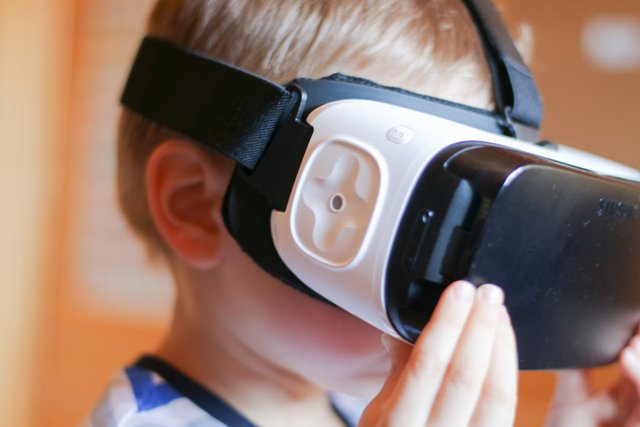
Image CC by 2.0
In anorexic patients, was verified a decrease in the degree of body wrong percection thanks to a realistic transposition of their natural image.
To the subject, who wears a headset and visualizes himself as an avatar, is asked to touch specific parts of the body, and these movements are projected into the virtual image, until total identification is created.
Using a technique called BodyTracing, then, the patient is invited to draw on a sheet the contours of her body as she perceives it, before the session. And then she is invited to do it again after being submitted to the immersive experience.
In short, perhaps after the countless flops of history, has been found an area in which virtual reality can find its great explosion.
To give continuity to the discourse and deepen even more the studies about the theme, in one of the upcoming posts, I will talk about some latest technological innovations applied to behavioral disorders and phobias.
Meanwhile, I thank you for reading and see you soon.
Bibliography
Riva, G., Bacchetta, M., Baruffi, M., & Molinari, E. (2001). Virtual Reality-Based Multidimensional Therapy for the Treatment of Body Image Disturbances in Obesity: A Controlled Study, CyberPsychology & Behavior, 4(4), 511-526.
Riva, G., Bacchetta, M., Baruffi, M., Rinaldi, S., & Molinari, E. (1999). Virtual reality based experiential cognitive treatment of anorexia nervosa, Journal of Behavior Therapy and Experimental Psychiatry, 30(3), 221-230.
Vincelli, F., & Riva, G. (2007), La Realtà Virtuale come supporto alla psicoterapia cognitivo-comportamentale, in Vincelli, F., Riva, G., & Molinari, E. (Eds.). La realtà virtuale in psicologia clinica. Nuovi percorsi di intervento nel disturbo di panico con agorafobia, pp. 67-92. Milano: McGraw-Hill.
Hoffman H. G., Doctor J. N., Patterson D. R., Carrougher G. J., Furness T. A., (2000) Virtual reality as an adjunctive pain control during burn wound care in adolescent patients. Pain. 85(1-2):305-9.
WEB Sources
- https://www.tomshw.it/storia-realta-virtuale-75901
- http://neuropsicotech.com/atn-p-lab/
- http://neuropsicotech.com/la-nuova-frontiera-della-riabilitazione-cave-automatic-virtual-environment-cave/
- Conversations between self and self as Freud
- https://www.ncbi.nlm.nih.gov/pubmed/26354311)
- http://www.fnopi.it/ecm/rivista-linfermiere/rivista-linfermiere-page-28-articolo-326.htm
- Body swapping protocol
GM
Hi @girolamomarotta
We have selected your post as post of the day for our DaVinci Times. Our goal is to help the scientific community of Steemit, and even if our vote is still small we hope to grow in quickly! You will soon receive our sincere upvote! If you are interested in science follow us sto learn more about our project.
Immagine CC0 Creative Commons, si ringrazia @mrazura per il logo ITASTEM.
CLICK HERE AND VOTE FOR DAVINCI.WITNESS
Keep in mind that for organizational reasons it’s necessary to use the “steemstem” and “davinci-times” tags to be voted again.
Greetings from @davinci.witness and the itaSTEM team.
Thanks a lot!
Greetings
Girolamo
Hi @girolamomarotta!
Your post was upvoted by utopian.io in cooperation with steemstem - supporting knowledge, innovation and technological advancement on the Steem Blockchain.
Contribute to Open Source with utopian.io
Learn how to contribute on our website and join the new open source economy.
Want to chat? Join the Utopian Community on Discord https://discord.gg/h52nFrV